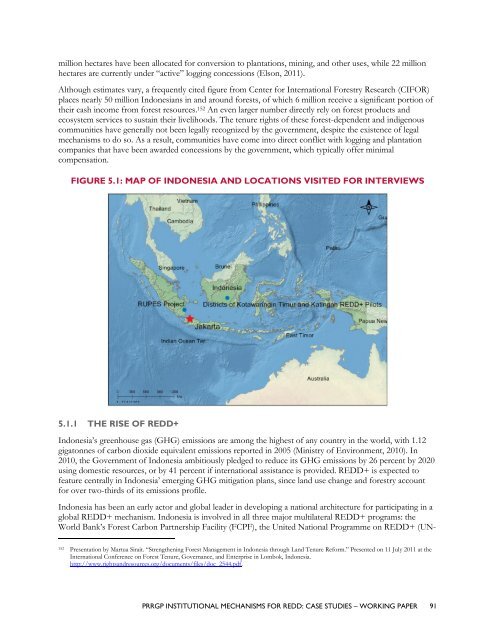Institutional Mechanisms for REDD+ - Case Studies Working Paper
Institutional Mechanisms for REDD+ - Case Studies Working Paper
Institutional Mechanisms for REDD+ - Case Studies Working Paper
Create successful ePaper yourself
Turn your PDF publications into a flip-book with our unique Google optimized e-Paper software.
million hectares have been allocated <strong>for</strong> conversion to plantations, mining, and other uses, while 22 million<br />
hectares are currently under ―active‖ logging concessions (Elson, 2011).<br />
Although estimates vary, a frequently cited figure from Center <strong>for</strong> International Forestry Research (CIFOR)<br />
places nearly 50 million Indonesians in and around <strong>for</strong>ests, of which 6 million receive a significant portion of<br />
their cash income from <strong>for</strong>est resources. 152 An even larger number directly rely on <strong>for</strong>est products and<br />
ecosystem services to sustain their livelihoods. The tenure rights of these <strong>for</strong>est-dependent and indigenous<br />
communities have generally not been legally recognized by the government, despite the existence of legal<br />
mechanisms to do so. As a result, communities have come into direct conflict with logging and plantation<br />
companies that have been awarded concessions by the government, which typically offer minimal<br />
compensation.<br />
FIGURE 5.1: MAP OF INDONESIA AND LOCATIONS VISITED FOR INTERVIEWS<br />
5.1.1 THE RISE OF <strong>REDD+</strong><br />
Indonesia‘s greenhouse gas (GHG) emissions are among the highest of any country in the world, with 1.12<br />
gigatonnes of carbon dioxide equivalent emissions reported in 2005 (Ministry of Environment, 2010). In<br />
2010, the Government of Indonesia ambitiously pledged to reduce its GHG emissions by 26 percent by 2020<br />
using domestic resources, or by 41 percent if international assistance is provided. <strong>REDD+</strong> is expected to<br />
feature centrally in Indonesia‘ emerging GHG mitigation plans, since land use change and <strong>for</strong>estry account<br />
<strong>for</strong> over two-thirds of its emissions profile.<br />
Indonesia has been an early actor and global leader in developing a national architecture <strong>for</strong> participating in a<br />
global <strong>REDD+</strong> mechanism. Indonesia is involved in all three major multilateral <strong>REDD+</strong> programs: the<br />
World Bank‘s Forest Carbon Partnership Facility (FCPF), the United National Programme on <strong>REDD+</strong> (UN-<br />
152 Presentation by Martua Sirait. ―Strengthening Forest Management in Indonesia through Land Tenure Re<strong>for</strong>m.‖ Presented on 11 July 2011 at the<br />
International Conference on Forest Tenure, Governance, and Enterprise in Lombok, Indonesia.<br />
http://www.rightsandresources.org/documents/files/doc_2544.pdf.<br />
PRRGP INSTITUTIONAL MECHANISMS FOR REDD: CASE STUDIES – WORKING PAPER 91

















